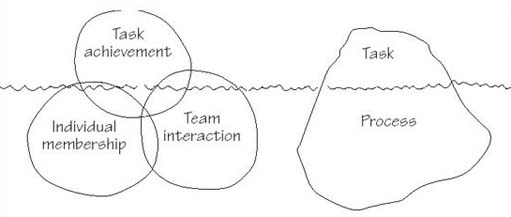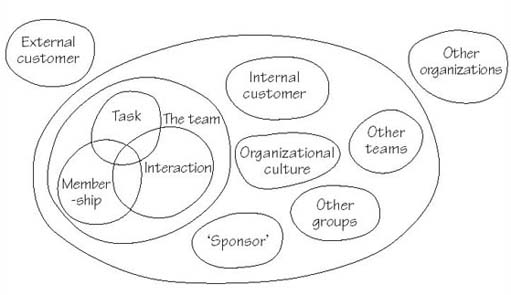2.8 Why do (only some) teams succeed?
Clearly, it is not possible to devise a set of rules which, if followed, would lead inexorably to team effectiveness. The determinants of a successful team are complex and not equivalent to following a set of prescriptions. However, the results of poor teamworking can be expensive, so it is useful to draw on research, experience and case studies to explore some general guidelines. What do I mean by 'team effectiveness'? – the achievement of goals alone? Where do the achievements of individual members fit in? and How does team member satisfaction contribute to team effectiveness?
Borrowing from Adair's 1983 leadership model, the left-hand side of Figure 3 shows the main constituents of team effectiveness: the satisfaction of individual membership needs, successful team interaction and the achievement of team tasks. These elements are not discrete, so Figure 3 shows them as overlapping. For example, team member satisfaction will be derived not only from the achievement of tasks but also from the quality of team relationships and the more social aspects of teamworking: people who work almost entirely on their own, such as teleworkers and self-employed business owner-managers, often miss the opportunity to bounce ideas off colleagues in team situations. The experience of solitude in their work can, over time, create a sense of isolation, and impair their performance. The effectiveness of a team should also relate to the next step, to what happens after the achievement of team goals.

The three elements could be reconfigured as an iceberg, most of which is below the water's surface (the right-hand side of Figure 3). Superficial observation of teams in organisations might suggest that most, if not all, energy is devoted to the explicit task (what is to be achieved, by when, with what budget and what resources). Naturally, this is important. But too often the concealed part of the iceberg (how the team will work together) is neglected. As with real icebergs, shipwrecks can ensue.
For instance, if working in a particular team leaves its members antagonistic towards each other and disenchanted with the organisation to the point of looking for new jobs, then it can hardly be regarded as fully effective, even if it achieves its goals. The measure of team effectiveness could be how well the team has prepared its members for the transition to new projects, and whether the members would relish the thought of working with each other again.
In addition to what happens inside a team there are external influences that impact upon team operations. The factors shown in Figure 4 interact with each other in ways that affect the team and its development. We don't really understand the full complexity of the nature of these interactions and combinations. The best that we can do is discuss each factor in turn and consider some of the interactions between them and how they relate to team effectiveness. For instance, discussions about whether the wider culture of an organisation supports and rewards teamworking, whether a team's internal and/or external customers clearly specify their requirements and whether the expectations of a team match those of its sponsor will all either help or hinder a team's ongoing vitality.

